So far, we have been using the Gradebook with number grades (apart from choosing to view these as letter grades). However, courses can also use scales, which are often words used for grading instead of numbers. In Chapter 2, Customizing Grades we set up a word scale for Not yet complete, Pass, Merit, and Distinction. When marking as assignment, we pick one of these words as the grade.
Remember that scales have a simple scoring system based on the number of items in the scale rather than true numbers. Therefore, they are not always the best option for complex calculations. However, let's use some scales in the Gradebook to see the calculations in action.
For this example, there are five tasks within the course, and each one is graded on the PMD scale set up in Chapter 2, Customizing Grades (with these options for grading: Not yet complete, Pass, Merit, and Distinction).
You can see how these have been graded so far in the following screenshot:

The course aggregation for this example has been set to Sum of grades, and the Gradebook adds together each grade that is awarded in order to show the course total.
Remember, from Chapter 2, Customizing Grades, the numbers that are used in calculations when using scales are based on the number of items in the scale. In this four-point scale, the grades will be 1 to 4 (Not yet complete = 1, Pass = 2, Merit = 3, and Distinction = 4) as the sum of grades is not a normalized scale.
Take a look at Emilie H in the previous screenshot. Her course total is 10. This is calculated in the following way:
3 (Merit) + 4 (Distinction) +3 (Merit) = 10.
Let's change the aggregation type from Sum of grades to Mean of grades in the Categories and items screen. Also, make sure that the course total at the bottom of the screen says 100.00. If it does not, then change the number and click on Save changes at the bottom of the screen. Go back to the Grader view to see how the course total has changed.

Take a look at Emilie H again. This aggregation method uses a normalization process, and the calculation is shown in the following table. As we know, the scores used with scales will always be based on the number of items in the scale and the Gradebook will always use either 0 or 1 (depending on the aggregation chosen) for the first item in the scale. When using normalized aggregation, methods scales start from 0, so the four-point scale will have a range from 0 to 3 (0 = Not yet complete, 1 = Pass, 2 = Merit, and 3 = Distinction).
|
Task 1 |
Task 2 |
Task 3 |
Total |
Mean aggregation |
The final grade shown in the Gradebook | |
|---|---|---|---|---|---|---|
|
Maximum grade possible |
3 (for distinction) |
3 |
3 | |||
|
Grade awarded |
2 (merit) |
3 (distinction) |
2 (merit) |
7 |
2.333 | |
|
Normalized grade |
0.6667 (2/3) |
1 (3/3) |
0.6667 (2/3) |
2.3334 (0.6667 + 1 + 0.6667) |
0.7778 (2.3334/3) |
77.78 (0.7778*100) |
This process will be the same for all normalized methods (with the aggregation calculation relevant to the method chosen).
In these two examples, the course total has been shown as numbers. However, it is possible to set the course total to use the scale as well.
- Go to the Categories and items area in the Gradebook and click on the edit button next to the Aggregation drop-down menu.
- In the Category total section, find the Grade type option and choose the scale from the list.
- This will activate the Scale drop-down list. From this list, choose the PMD scale, which is the same scale used for the individual assessments.
- Click on the Show more text to view the Grade display type options.
- Make sure that the Grade display type option says Real and Save changes at the bottom of the screen.

- Now, switch back to View the Grader report option again.
You can see that the course total is now using the same scale as the graded items.

The Course total scale uses the same scoring as the individual items and uses the aggregation method to decide which item of the scale is to be displayed.
Take a look at Emilie H again. Remember that the normalized total was 2.3334. As two equates to Merit in this four-point scale, Merit is shown as the course grade. Remember, this example does not use the nongraded assessments in the total, so the grade will change as other assignments are completed. If the normalized grade is calculated as .5, the final grade will be rounded up. For example, the normalized grade of Bayley W will be 2.5 (a grade of 2 for Merit and a grade of 3 for Distinction to make a total of 5.) This, divided by two for the number of grades in the mean calculation, provides the 2.5 normalized total. This is rounded up to display a final course grade of Distinction.
